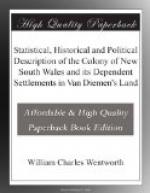Rude and barbarous as are the aborigines of this country, they have still some confused notions of a Supreme Being and of a future state. It would, however, be foreign to the purposes to which I have limited myself, to enter into a detail of their customs and manners; nor would it, indeed, be the means of increasing the fund of public knowledge: since, whoever may be anxious to be informed on these topics, will find a faithful and minute account of them in the work of Mr. Collins.
Sydney, the capital of New South Wales, is situated in 33 degrees 55’ of south latitude, and 151 degrees 25’ of east longitude. It is about seven miles distant from the heads of Port Jackson, and stands principally on two hilly necks of land and the intervening valley, which together form Sydney Cove. The western side of the town extends to the water’s edge, and occupies with the exception of the small space reserved around Dawe’s Battery, the whole of the neck of land which separates Sydney Cove from Lane Cove, and extends a considerable distance back into the country besides.
This part of the town, it may therefore be perceived, forms a little peninsula; and what is of still greater importance the water is in general of sufficient depth in both these coves, to allow the approach of vessels of the largest burden to the very sides of the rocks.
On the eastern neck of land, the extension of the town has been stopped by the Government House, and the adjoining domain, which occupies the whole of Bennilong’s Point, a circumstance the more to be regretted, as the water all along this point is of still greater depth than on the western side of the Cove, and consequently affords still greater facilities for the erection of warehouses and the various important purposes of commerce.
The appearance of the town is rude and irregular. Until the administration of Governor Macquarie, little or no attention had been paid to the laying out of the streets, and each proprietor was left to build on his lease, where and how his caprice inclined him. He, however, has at length succeeded in establishing a perfect regularity in most of the streets, and has reduced to a degree of uniformity, that would have been deemed absolutely impracticable, even the most confused portion of that chaos of building, which is still known by the name of “the rocks;” and which, from the ruggedness of its surface, the difficulty of access to it, and the total absence of order in its houses, was for many years more like the abode of a horde of savages than the residence of a civilized community. The town upon the whole may be now pronounced to be tolerably regular; and, as in all future additions that may be made to it, the proprietors of leases will not be allowed to deviate from the lines marked out by the surveyor general, the new part will of course be free from the faults and inconveniences of the old.




